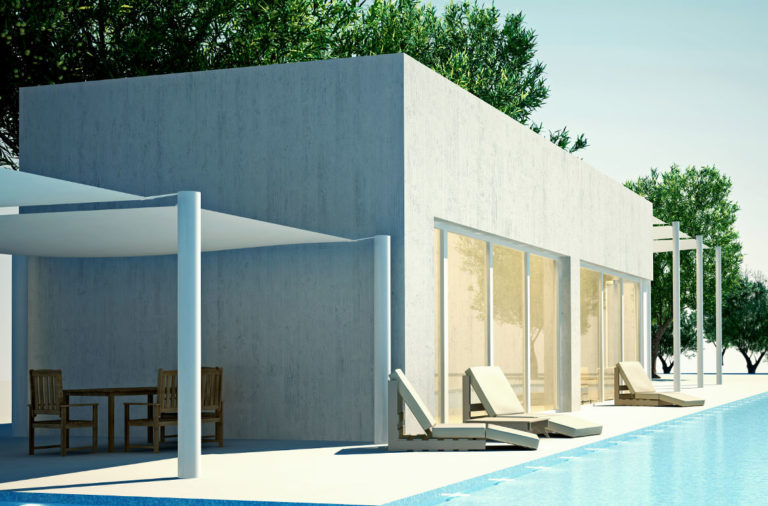
You may want to know – What you need to do in order to build a granny flat on a challenging block?
- You will need to work with your restraints in mind, such as making sure everything can fit it on your site, whilst adhering to all regulations, such as setbacks and Principal Private Open Space (PPOS).
- To help you with this, you may need to enlist the help of specialists, such as surveyors, engineers, and possibly, an architect or building designer, to ensure your plans are approved by Council.
Today, I will cover:
- What trades/specialties will you need for a challenging block?
- Will you need an architect or drafter?
- Examples of companies who specialise in challenging blocks.
- Will Council knock you back on your plans?
- Can you be issued with a CDC or do you need a DA for a challenging block?
- Last words of caution when it comes to a granny flat on a challenging block.
DON'T PAY A FORTUNE FOR YOUR GRANNY FLAT. Find out how to deal with council and build a granny flat for the lowest cost possible. Learn More.
So, no need to sit around, let’s get started.
What Trades/Specialties Will You Need for a Challenging Block?
It is best that you work with what you have not against it.

Building a granny flat on a steep block can be harder
So if you design your area with your restraints in mind, your outcome will be better.
The trades and specialists that can help you with this are:
- Surveyors – If you have a challenging block, a Land Surveyor will ensure your boundaries are accurately measured and marked, and preliminary markers are ‘set out’ (placed) where you plan to put your granny flat.
Not only can they provide advice and details to help lead the way for the work of engineers, architects, etc., this data is important, as it ensures your plans will meet the regulations of Council.
- Engineers – An experienced, intelligent can put their problem-solving skills to use on a challenging block, to help you find ways to progress with building a granny flat that works within your budget.
- Possibly, an architect or building designer – An architect or building designer with design experience will ensure you get the most out of y0ur block, which I will elaborate on below.
They are also armed with an understanding of the cost of the materials you will need. This will help to make sure that you do not get any expensive surprises when it comes to construction costs.
Will You Need an Architect or Drafter?
I suggest that you use an architect for a challenging block.
In general, an architect will work with you in a different manner than a drafter. This contrast can take more time.
For example, an architect will:
- Spend extra time on design – Design is their forte, so they spend a lot more time investigating during this period. This includes quizzing you about what you want from your granny flat.
- Be inclined to do more drawings – As they are so passionate about design, they convey this through their drawings, so it gets built.
They are a specialist in design, so are experts at making the best use of your block. They can explore all design options available for a challenging block, as is shown here in a detailed look of architecturally designed granny flats.
To put it simply, an architect may have more knowledge in “solving problems” for your challenging block.
NOTE: You will pay more for their extra qualifications and experience. Architects charge more than drafters, however for challenging blocks I feel they are absolutely worth it.
Examples of Companies Who Specialise in Challenging Blocks
Great companies to research that specialise in challenging blocks are those that build architecturally designed granny flats.
I have put together a list of highly recommended companies below. Some, of whose projects you can view on their sites below:
- Bibo Build – (02) 9160 2222.
- Sydney Designer Granny Flats – (02) 9498 8260.
- RK Designs – (02) 9633 4797.
- Infinite Architecture Design – 1300 033 933 / 0421 723 667.
- Newcastle Designer Granny Flats – (02) 4947 2800.
- Backspace Living – 1300 561 169.
- Rescon Builders – 1300 108 365.
- Aspect Z – (02) 4321 0970.
- East Coast Granny Flats – 1300 252 858.
- Backyard Grannys – 1300 347 953.
- Creative Spaces Australia – 0400 461 463.
- Lifestyle Granny Flats – (07) 3367 8222.
- Avalon Granny Flats – 0406 488 814.
- ArkSpace Architects
- The Design Files
Will Council Knock You Back With Your Plans?
It is possible, on a challenging block, if your plans have NOT been designed to meet all of your Councils’ regulations, that they will not be approved.
For example, you may be on a narrow block, and so that makes the design quite complicated. You need to make sure that everything will fit on your site, whilst adhering to all regulations, such as setbacks and Principal Private Open Space (PPOS).
Again, this is where it can really help to enlist the experience of a professional architect when planning your design.
They will take all of your surroundings into consideration, such as:
- The height of any adjacent neighbours’ buildings
- Your setbacks, and
- All of the areas that overlook your block
- The placement of your windows, to ensure your privacy remains intact, and you will not raise any concerns with your neighbours
- Making the most of the Northerly aspect for sun light
Basically, an architect will help you work with the challenging block, and help you create ideal plans that Council will not disapprove.
Can You Be Issued with a CDC or Do You Need a DA for a Challenging Block?
As long as your block can meet all the regulations of the SEPP, you can be approved by Complying Development (CDC).
It is important to note that, for challenging blocks, you may run into the following issues mentioned under the sub-heading below.
Last Words of Caution When it Comes to a Challenging Block
When building a granny flat, a challenging block takes time. You need time to really asses your lot and its’ most important factors, such as its’:
- Shape.
- Slope.
- Size, property type, and the setbacks required. I will elaborate on the importance of this shortly.
- Sewer lines.
- Feasibility of access.
For example, if you have a sloping block, the cost of excavation can cost a small fortune.
Not only is the price to bring in the equipment, such as diggers, expensive, you also have to pay to dump the soil. This can be extremely pricey. You also need to think about whether the equipment can access your site.
Another example is what I was quoted when I built my granny flat.
As I was building on a sloping block, I had to incur the extra costs of having to add in retaining walls. We were quoted $12, 000 for the one above our granny flat, as they needed to:
- Further excavate, and
- Add in concrete and steel reinforcement for footings, which is not cheap either.
Then, you have the cost of the labour for a bricklayer to lay the bricks for the retaining wall, plus added drainage, ag pipes, and blue metal to keep the drainage at bay as well.
I am happy for you to see exactly what I did pay when I built my granny flat, as I documented all the costs.
The last point to mention are to foresee the challenges of getting all the building material on site. I was quoted by a plaster for our internal walls, by him just looking at the plans I emailed over. When we arrived on site he wanted to charge me a whole lot more, as he said the “guys took longer than expected to bring the materials down”.
I didn’t agree with this, but a small compromise was made on the price and I added a ‘tip’ for the work down.
Conclusion
A challenging block can be complex to design a granny flat on, but the results that are created can be unique and lovely.
It can help to enlist the assistance of professionals, such as an architect or building designer, engineer, and surveyor.
These specialists will help you with plans that will be Council-approved through Complying Development.
So even if you have sloping land, a narrow block, or any other challenges, they have the knowledge to make it work.












